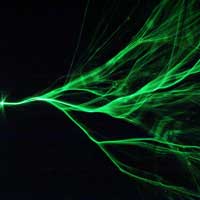 Researchers coupled a laser beam to a soap membrane, which contains random variations in membrane thickness. They discovered that when light propagates within the soap film, rather than being scattered, the light forms elongated branches, creating the branched flow phenomenon for light.
Researchers coupled a laser beam to a soap membrane, which contains random variations in membrane thickness. They discovered that when light propagates within the soap film, rather than being scattered, the light forms elongated branches, creating the branched flow phenomenon for light.
Wednesday, July 1, 2020
Researchers observe branched flow of light for the first time
 Researchers coupled a laser beam to a soap membrane, which contains random variations in membrane thickness. They discovered that when light propagates within the soap film, rather than being scattered, the light forms elongated branches, creating the branched flow phenomenon for light.
Researchers coupled a laser beam to a soap membrane, which contains random variations in membrane thickness. They discovered that when light propagates within the soap film, rather than being scattered, the light forms elongated branches, creating the branched flow phenomenon for light.
Laser takes pictures of electrons in crystals
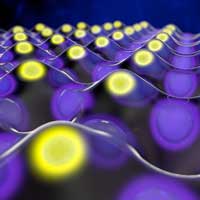 Light microscopes cannot discern how electrons are distributed among atoms in solids. A new type of a light microscope, the Picoscope, that allows overcoming this limitation.
Light microscopes cannot discern how electrons are distributed among atoms in solids. A new type of a light microscope, the Picoscope, that allows overcoming this limitation.
Tabletop quantum experiment with nanocrystals could detect gravitational waves
 Diamond nanocrystals could be used as an incredibly sensitive and small gravitational detector capable of measuring gravitational waves.
Diamond nanocrystals could be used as an incredibly sensitive and small gravitational detector capable of measuring gravitational waves.
Magnonic nano-fibers opens the way towards new type of computers
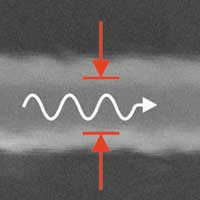 Scientists report a critical advancement in the field of ultralow power computation using magnetic waves.
Scientists report a critical advancement in the field of ultralow power computation using magnetic waves.
Building better electron sources with graphene
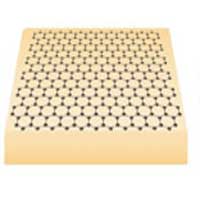 Graphene substrates can be reused repeatedly for photocathodes that emit high-brightness electron beams in electron microscopes and accelerators.
Graphene substrates can be reused repeatedly for photocathodes that emit high-brightness electron beams in electron microscopes and accelerators.
New materials of perovskite challenge the chemical intuition
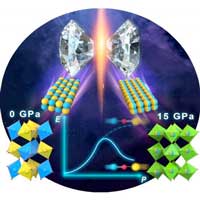 Materials scientists have synthesized a new type of perovskite that goes against conventional thinking about how such structures behave at extreme pressures such as those that exist deep in the Earth.
Materials scientists have synthesized a new type of perovskite that goes against conventional thinking about how such structures behave at extreme pressures such as those that exist deep in the Earth.
High-end microscopy refined
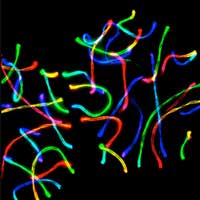 Scientists have been able to map the synaptonemal complex three-dimensionally with a resolution of 20 to 30 nanometres.
Scientists have been able to map the synaptonemal complex three-dimensionally with a resolution of 20 to 30 nanometres.
Architecture is key: Biomolecule metal-organic hybrids with high bioactivity
 Biomacromolecules incorporated into tailored metal?organic frameworks using peptide modulators are well shielded but highly active thanks to carefully tuned nanoarchitecture.
Biomacromolecules incorporated into tailored metal?organic frameworks using peptide modulators are well shielded but highly active thanks to carefully tuned nanoarchitecture.
Bubbling and burping droplets of DNA
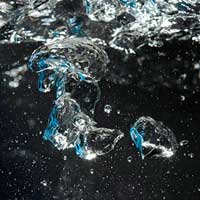 Liquid droplets formed from DNA display a peculiar response to enzymes.
Liquid droplets formed from DNA display a peculiar response to enzymes.
Scientists use a Teflon pipe to make a cheap, simple reactor for silica particle synthesis
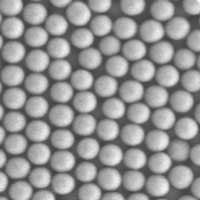 Functional silica beads for biomedical imaging, drug delivery and other important applications could be made using an easy new flow synthesis method.
Functional silica beads for biomedical imaging, drug delivery and other important applications could be made using an easy new flow synthesis method.
Stabilizing water loss in synthetic trees
 Scientists are developing 'synthetic trees' that work like their natural counterparts to serve in specific applications. In an important step, scientists fabricated synthetic leaves using nanoporous disks.
Scientists are developing 'synthetic trees' that work like their natural counterparts to serve in specific applications. In an important step, scientists fabricated synthetic leaves using nanoporous disks.
Being exceptional in higher dimensions
 By connecting electromagnetic waves and magnetism to create a system made of magnon polaritons, scientists demonstrated the existence of an 'exceptional surface' for the first time.
By connecting electromagnetic waves and magnetism to create a system made of magnon polaritons, scientists demonstrated the existence of an 'exceptional surface' for the first time.
New chemistry for ultra-thin gas sensors
 Researchers established a new fabrication process based on a non-pyrophoric zinc precursor that can be processed at temperatures low enough to allow plastics to be coated.
Researchers established a new fabrication process based on a non-pyrophoric zinc precursor that can be processed at temperatures low enough to allow plastics to be coated.
Building a harder diamond
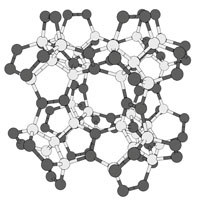 Scientists use computer calculations to propose a new way to rearrange the carbon atoms in a diamond to make it even harder, which may be useful in industrial applications that rely on synthetic cutting diamonds .
Scientists use computer calculations to propose a new way to rearrange the carbon atoms in a diamond to make it even harder, which may be useful in industrial applications that rely on synthetic cutting diamonds .
Subscribe to:
Comments (Atom)
